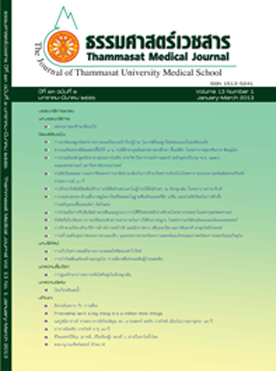Efficacy and complications of gynecologic endoscopic surgery in Thammasat university hospital: A 10-year experience
Keywords:
Laparoscopy, Hysteroscopy, ComplicationsAbstract
Introduction: The role of endoscopic surgery for gynecology has significantly increased. The objective of the study wasto evaluate the efficacy and complications of gynecologic endoscopic surgery in Thammasat universityhospital in the past decade.
Methods: Retrospective, descriptive study was conducted by a retrospective analysis of medical records from 335women who underwent gynecological endoscopy surgery in Thammasat university hospital.A total of 335 women in this study were recruited during 1 January 1997 to 31 December 2007.
Results: The endoscopic surgery consisted of laparoscopy and hysteroscopy at 301 and 34 cases, respectively.The most common therapeutic procedure was laparoscopic cystectomy. It was contributed at percentageof 44.5. Another most common investigation procedure was diagnostic hysteroscopy. The percentage ofdiagnostic hysteroscopy in abnormal uterine bleeding cases was 38.2%. Laparoscopic complication ratewas 9.9% (30/301) in overall. The blood transfusion, conversion to exploratory laparotomy, vesico-vaginalfistula, urinary bladder and bowel injury were 4.6%, 2.6%, 1.3%, 1.0% and 0.3%, respectively. Theseadverse events were related to the complexity of procedure such as laparoscopic hysterectomy andsevere endometriosis. There were two cases of uterine perforation (5.8%). It was the major complicationof hysteroscopy in this study.
Conclusion: The laparoscopy and hysteroscopy have high efficacy. It is considered as safe procedures. Most complicationsare correctable, controllable and non-mortality.
Key words: Laparoscopy, Hysteroscopy, Complications


